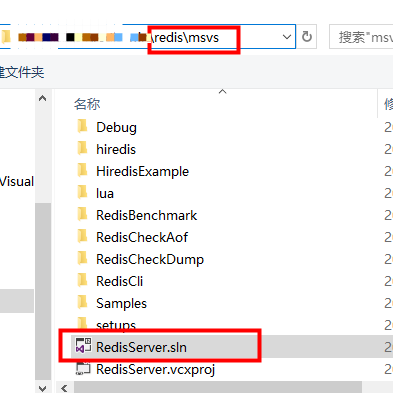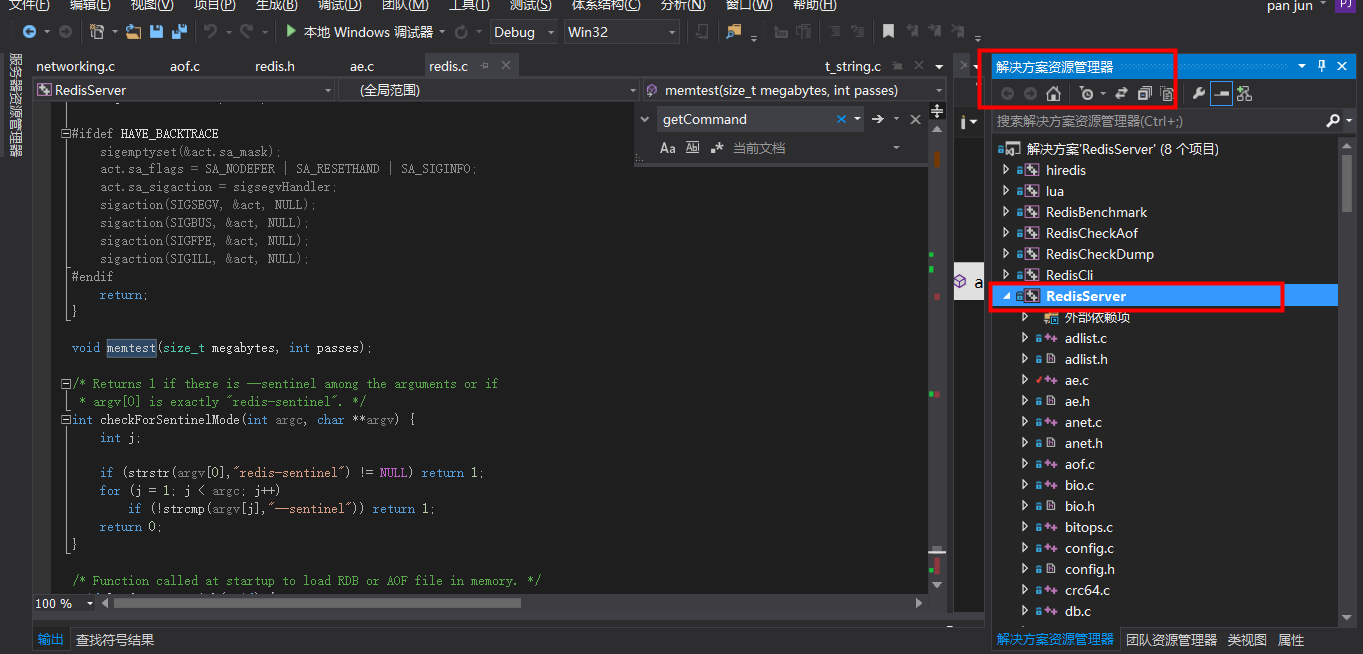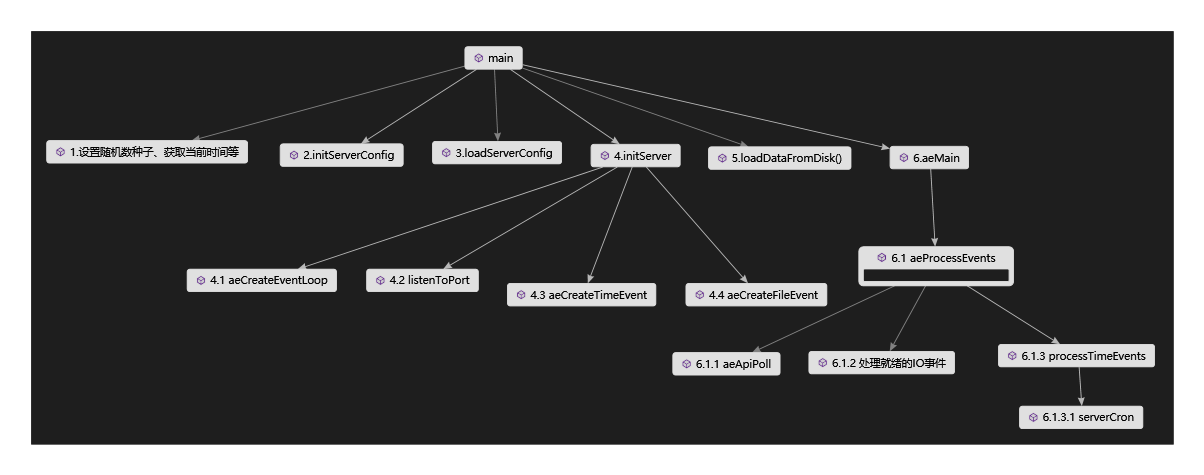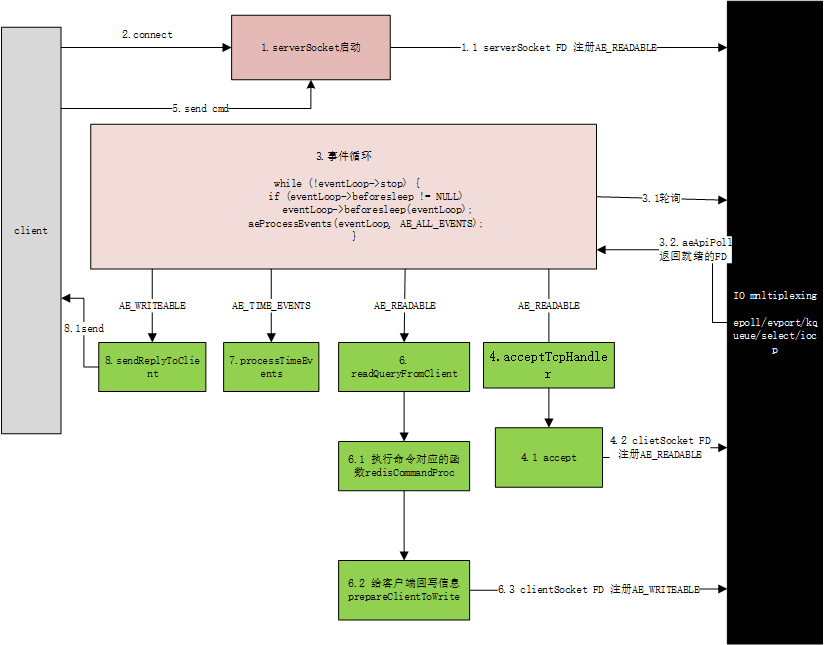redis源码学习之工作流程初探
背景
redis是当下比较流行的KV数据库之一,是抵御高并发的一把利器,本着知其然还要知其所以然的目的,我决定花一点时间来研究其源码,希望最后能向自己解释清楚“redis为什么这么快”这个疑惑,第一篇主要介绍环境搭建和redis工作流程初探,后期会陆续献上其他有意思的章节。
环境准备
我自己的电脑是win10系统,所以我会准备一套适合windows系统的环境来供自己学习,这样方便调试分析。
下载redis源码
redis本身是不支持windows系统的,但是微软的工程师针对windows平台做了支持,源码放在了github上,有需要的可以自己去下载,我这里下载的是v2.8.9这个tag的源码,下载地址https://github.com/microsoftarchive/redis。这里扯个题外话,学习一个开源软件的时候不要一上来就下载最新版本的源码看,经过的迭代太多代码量就上来了,对于新手来说容易晕,先下一个早期的稳定版本了解其体系结构和工作流程,等待熟悉了以后再循序渐进。
下载Visual Studio
其他软件我没尝试过,这个是官方推荐的ide,一定一定一定下载 Visual Studio 2013 update5这个版本的,否则编译的时候各种报错,下载地址
http://download.microsoft.com/download/9/3/E/93EA27FF-DB02-4822-8771-DCA0238957E9/vs2013.5_ult_chs.iso。这里再扯个题外话,我刚开始下载的是最新版本的Visual Studio,结果编译的时候各种报错,然后就去网络上一顿查一顿试,折腾半天还是没好,最后下载了 Visual Studio 2013 update5这个版本,结果一把就成功,有些牛角尖一定得钻,但是有些牛角尖不值得钻。
Visual Studio打开redis源码
按照下图方式打开下载的redis源码



c程序的入口是main方法,redis main方法的位置在redis.c文件中,下面我们通过main方法来逐步了解redis的工作流程。
启动过程分析
跟着main方法顺序看下去,大概有以下几个关键步骤(略过了sentinel相关逻辑):
1.设置随机数种子、获取当前时间等;
2.初始化服务配置信息,设置默认值(initServerConfig);
3.解析配置文件(loadServerConfig);
4.初始化server对象(initServer);
4.1创建eventLoop对象;
4.2创建serverSocket,监听端口;
4.3添加定时事件到eventLoop对象中;
4.4将serverSocket文件描述符添加到监视集中,这里借助IO多路复用框架的能力(windows平台使用IOCP,其他平台使用select、epoll、evport等);
5.从磁盘加载数据到内存中(loadDataFromDisk);
6.执行事件循环逻辑(aeMain),这是redis真正挥洒汗水的地方,下一节会单独讲述这块内容。
调用关系图

事件循环分析
我们都知道redis是单线程执行客户端命令的,那究竟是怎样一种设计才能支持高并发的读写呢。
工作模型
1.server启动,创建serverSocket监听端口,将serverSocket对应的FD(文件描述符)简称为FD-Server添加到IO多路复用框架的监视集当中,注册AE_READABLE事件(可读),关联的事件处理器是acceptTcpHandler;
2.client连接server;
3.事件循环开始轮询IO多路复用框架接口aeApiPoll,会得到就绪的FD,执行对应的事件处理器;
4.由第3步事件循环触发FD-Server AE_READABLE事件对应的事件处理器acceptTcpHandler;
4.1调用accept获得clientSocket对应的FD简称为FD-Client;
4.2将FD-Client添加到IO多路复用框架的监视集当中,注册AE_READABLE事件(可读),关联的事件处理器是readQueryFromClient;
5.client发送redis命令;
6.由第3步事件循环触发FD-Clien AE_READABLE事件对应的事件处理器readQueryFromClient;
6.1解析客户端发来的redis命令,找到命令对应的redisCommandProc(命令对应的处理函数);
6.2执行redisCommandProc;
6.3prepareClientToWrite准备回写响应信息,为FD-Client注册AE_WRITEABLE事件(可写),关联的事件处理器是sendReplyToClient;
7.执行redis中的定时任务;
8.由第3步事件循环触发FD-Clien AE_WRITEABLE事件对应的事件处理器sendReplyToClient,发送响应内容给client;

代码分析
server启动,创建serverSocket并注册AE_READABLE事件,设置事件处理器为acceptTcpHandler
void initServer() {
//省略部分代码
//初始化eventLoop对象,eventLoop对象里面存储了所有的事件
server.el = aeCreateEventLoop(server.maxclients+REDIS_EVENTLOOP_FDSET_INCR);
//创建serverSocket,监听端口
if (server.port != 0 &&
listenToPort(server.port,server.ipfd,&server.ipfd_count) == REDIS_ERR)
exit(1);
//添加定时任务到eventLoop中
if(aeCreateTimeEvent(server.el, 1, serverCron, NULL, NULL) == AE_ERR) {
}
//将serverSocket对应的文件描述符添加到监视集中,关联的事件处理器是acceptTcpHandler
for (j = 0; j < server.ipfd_count; j++) {
if (aeCreateFileEvent(server.el, server.ipfd[j], AE_READABLE,
acceptTcpHandler,NULL) == AE_ERR)
}
}
acceptTcpHandler当有连接过来的时候被触发,调用accept得到client socket对应的FD,并将FD添加到监视集中,关联的事件处理器是readQueryFromClient
void acceptTcpHandler(aeEventLoop *el, int fd, void *privdata, int mask) {
int cport, cfd;
//调用accept获得clientSocket对应的FD
cfd = anetTcpAccept(server.neterr, fd, cip, sizeof(cip), &cport);
//将clientSocket对应的FD添加到监视集中
acceptCommonHandler(cfd,0);
}
static void acceptCommonHandler(int fd, int flags) {
redisClient *c;
//调用createClient添加
if ((c = createClient(fd)) == NULL) {
}
}
redisClient *createClient(int fd) {
redisClient *c = zmalloc(sizeof(redisClient));
if (fd != -1) {
anetNonBlock(NULL,fd);
anetEnableTcpNoDelay(NULL,fd);
if (server.tcpkeepalive)
anetKeepAlive(NULL,fd,server.tcpkeepalive);
//将fd添加到监视集中,关联的事件处理器是readQueryFromClient
if (aeCreateFileEvent(server.el,fd,AE_READABLE,
readQueryFromClient, c) == AE_ERR)
{
}
}
}
aeMain就是跑一个循环,一直去调用aeProcessEvents
void aeMain(aeEventLoop *eventLoop) {
eventLoop->stop = 0;
while (!eventLoop->stop) {
if (eventLoop->beforesleep != NULL)
eventLoop->beforesleep(eventLoop);
aeProcessEvents(eventLoop, AE_ALL_EVENTS);
}
}
aeProcessEvents会调用aeApiPoll方法来获得就绪的文件描述符,然后执行文件描述符关联的的事件处理器
int aeProcessEvents(aeEventLoop *eventLoop, int flags)
{
int processed = 0, numevents;
#ifdef _WIN32
if (ServiceStopIssued() == TRUE)
aeStop(eventLoop);
#endif
/* Nothing to do? return ASAP */
if (!(flags & AE_TIME_EVENTS) && !(flags & AE_FILE_EVENTS)) return 0;
/* Note that we want call select() even if there are no
* file events to process as long as we want to process time
* events, in order to sleep until the next time event is ready
* to fire. */
if (eventLoop->maxfd != -1 ||
((flags & AE_TIME_EVENTS) && !(flags & AE_DONT_WAIT))) {
int j;
aeTimeEvent *shortest = NULL;
struct timeval tv, *tvp;
if (flags & AE_TIME_EVENTS && !(flags & AE_DONT_WAIT))
shortest = aeSearchNearestTimer(eventLoop);
if (shortest) {
long now_sec, now_ms;
/* Calculate the time missing for the nearest
* timer to fire. */
aeGetTime(&now_sec, &now_ms);
tvp = &tv;
tvp->tv_sec = shortest->when_sec - now_sec;
if (shortest->when_ms < now_ms) {
tvp->tv_usec = ((shortest->when_ms+1000) - now_ms)*1000;
tvp->tv_sec --;
} else {
tvp->tv_usec = (shortest->when_ms - now_ms)*1000;
}
if (tvp->tv_sec < 0) tvp->tv_sec = 0;
if (tvp->tv_usec < 0) tvp->tv_usec = 0;
} else {
/* If we have to check for events but need to return
* ASAP because of AE_DONT_WAIT we need to set the timeout
* to zero */
if (flags & AE_DONT_WAIT) {
tv.tv_sec = tv.tv_usec = 0;
tvp = &tv;
} else {
/* Otherwise we can block */
tvp = NULL; /* wait forever */
}
}
numevents = aeApiPoll(eventLoop, tvp);
for (j = 0; j < numevents; j++) {
aeFileEvent *fe;
int mask = eventLoop->fired[j].mask;
int fd = eventLoop->fired[j].fd;
int rfired = 0;
fe = &eventLoop->events[eventLoop->fired[j].fd];
/* note the fe->mask & mask & ... code: maybe an already processed
* event removed an element that fired and we still didn't
* processed, so we check if the event is still valid. */
if (fe->mask & mask & AE_READABLE) {
rfired = 1;
fe->rfileProc(eventLoop,fd,fe->clientData,mask);
}
if (fe->mask & mask & AE_WRITABLE) {
if (!rfired || fe->wfileProc != fe->rfileProc)
fe->wfileProc(eventLoop,fd,fe->clientData,mask);
}
processed++;
}
}
/* Check time events */
if (flags & AE_TIME_EVENTS)
processed += processTimeEvents(eventLoop);//处理延迟任务
return processed; /* return the number of processed file/time events */
}
动画演示
做了一个动画帮助理解工作过程(redis启动之后使用命令行telnet到6379端口,然后执行keys *命令,最终拿到结果)

网络模块
IO多路复用
这部分内容网络上精彩的内容太多,这里把我认为比较经典的一些内容贴出来供大家品读(建议从上往下顺序阅读)
The C10K problem
socket阻塞非阻塞等头疼问题解释
LINUX – IO MULTIPLEXING – SELECT VS POLL VS EPOLL
poll vs select vs event-based
redis事件驱动







【推荐】国内首个AI IDE,深度理解中文开发场景,立即下载体验Trae
【推荐】编程新体验,更懂你的AI,立即体验豆包MarsCode编程助手
【推荐】抖音旗下AI助手豆包,你的智能百科全书,全免费不限次数
【推荐】轻量又高性能的 SSH 工具 IShell:AI 加持,快人一步
· 基于Microsoft.Extensions.AI核心库实现RAG应用
· Linux系列:如何用heaptrack跟踪.NET程序的非托管内存泄露
· 开发者必知的日志记录最佳实践
· SQL Server 2025 AI相关能力初探
· Linux系列:如何用 C#调用 C方法造成内存泄露
· 无需6万激活码!GitHub神秘组织3小时极速复刻Manus,手把手教你使用OpenManus搭建本
· Manus爆火,是硬核还是营销?
· 终于写完轮子一部分:tcp代理 了,记录一下
· 别再用vector<bool>了!Google高级工程师:这可能是STL最大的设计失误
· 单元测试从入门到精通